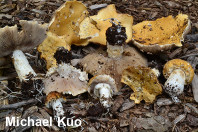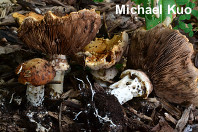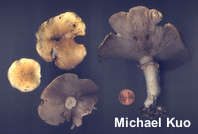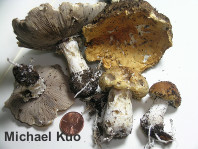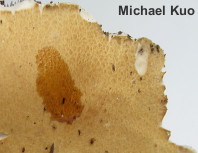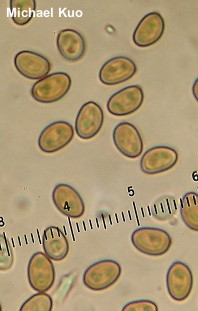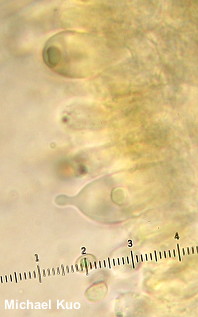| Major Groups > Gilled Mushrooms > Dark-Spored > Stropharioid Mushrooms > Stropharia hardii |

|
Stropharia hardii [ Basidiomycota > Agaricales > Strophariaceae > Stropharia . . . ] by Michael Kuo Stropharia hardii is most frequently encountered in the Ohio River watershed, but it is fairly widely distributed east of the Great Plains. It resembles an Agaricus in many ways, but its gills are attached to the stem and usually develop a purplish gray or purplish brown cast by maturity. It is a drab, dirty yellowish species that is unremarkable except for its fairly large size. The cap is bald and dry, and the stem is smooth underneath a persisting ring. Distinguishing microscopic features include its small spores and the presence of chrysocystidia. Compare Stropharia hardii with Stropharia kauffmanii (cap and stem scaly, range northern and montane) and Stropharia hornemannii (cap reddish and slimy, spores much larger, range northern and montane). Description: Ecology: Saprobic; growing alone, scattered, or gregariously on woody debris in hardwood forests or on woodchips; summer and fall; widely distributed east of the Great Plains. The illustrated and described collections are from Illinois. Cap: 4–10 cm; convex, becoming broadly convex or nearly flat; sticky at first, but soon dry; brown in button stage but soon golden brown to brownish yellow; bald overall, with a few inconspicuous, dark brownish spots or tiny innate scales; the margin not lined. Gills: Narrowly attached to the stem; crowded; short-gills frequent; beige at first, becoming brownish gray and eventually dark brown with a purplish hue. Stem: 3–8 cm long; 1–2 cm thick; equal; dry; with a fragile but persistent white ring that features a lined upper edge; bald or finely hairy (but not conspicuously shaggy-scaly); white, discoloring yellowish brown in places; base often with white mycelial threads. Flesh: White; unchanging when sliced. Odor and Taste: Odor not distinctive, or slightly foul and reminiscent of creosote; taste not distinctive, or slightly foul.Chemical Reactions: KOH dull brownish orange on cap surface. Spore Print: Dark brown with a purplish hue. Microscopic Features: Spores 5–7 x 3–4.5 µm; ellipsoid; without a pore; smooth; yellow-brown in KOH. Pleurocystidia as chrysocystidia; 30–55 x 8–12.5 µm; clavate or clavate-rostrate; smooth; thin-walled; hyaline, with a refractive, ochraceous inclusion. Pileipellis a cutis; golden brown in KOH; elements 5–12.5 µm wide, clamped at septa, smooth or finely encrusted. REFERENCES: Atkinson, 1906. (Stamets, 1978; Smith, Smith & Weber, 1979; Weber & Smith, 1985; Phillips, 1991/2005; Lincoff, 1992; Roody, 2003; McNeil, 2006; Kuo & Methven, 2014.) Herb. Kuo 08300205, 08291406. This site contains no information about the edibility or toxicity of mushrooms. |
© MushroomExpert.Com |
|
Cite this page as: Kuo, M. (2016, August). Stropharia hardii. Retrieved from the MushroomExpert.Com Web site: http://www.mushroomexpert.com/stropharia_hardii.html |
